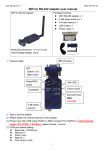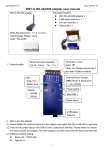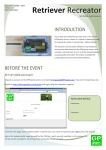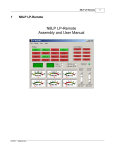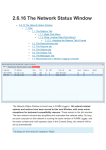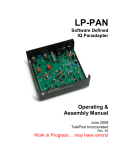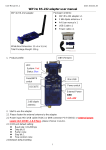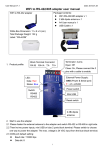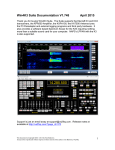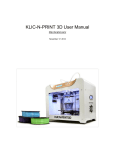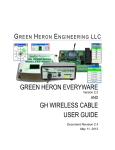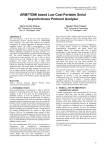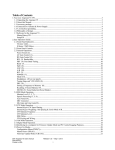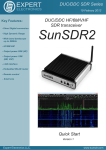Download Using Virtual Serial Ports
Transcript
ELECRAFT Application Note Using Virtual Serial Ports with Logging and Contest Software Revision B2, August 14, 2015 Copyright © 2015, Elecraft, Inc.; All Rights Reserved Introduction Many contact and contest logging programs require the use of dual COM ports at the host computer for transceiver control and keying. This Application Note introduces methods for concentrating multiple computer COM ports to a single transceiver serial port, using COM Port Concentrator (CPC) software. An example is used for illustration purposes. A typical CPC scenario consists of one computer COM port used for keying and PTT, with another COM port used for remote control. The transceiver, of course, only has a single port. The transceiver port may be implemented as plain RS232, via a USB-serial adapter, or less often via other interfaces such as Ethernet or Wi-Fi. The CPC software binds the two computerinternal (virtual) COM ports into a single externally-accessible physical serial port. The two virtual ports are used by the logging program, while the single physical port is connected to the transceiver. Scope This App Note is written for Amateurs that require detailed knowledge about COM port concentrators and the configuration of logging programs. The example used is specific to the Elecraft K3S and K3, but nearly all concepts presented also apply to other Amateur transceivers that have serial ports. This Note is limited to the use of Microsoft Windows™ and application software designed for that operating system. CPC Types There are two types of CPCs: Polling and Direct. A polling CPC continuously queries the transceiver for its state (frequency, mode, etc.) and maintains a local copy or “cache” to use in reply to the logger application’s queries. A direct CPC doesn’t maintain a local copy of the transceiver’s state. Both types of concentrators support the modem control signals DTR and RTS, used in keying and PTT at the transceiver. A polling CPC is always designed to work with a specific serial port-based device type (say, a K3). A direct CPC is device-agnostic. An example of a polling CPC is LP Bridge, a software program developed and maintained by Telepost, Inc. LP Bridge is a full-featured CPC that was designed to work with the Elecraft K3S and K3 transceivers. Elecraft • www.elecraft.com • 831-763-4211 Technical content subject to change without notice For more information, please contact: [email protected] There are many examples of direct CPCs. One that is in common use is VSPE, developed and maintained by Eterlogic.com. VSPE is a full-featured direct CPC. This Application Note does not show any examples of using VSPE, to keep the Note brief. Because the polling type of CPC acts as a “stand in” for the transceiver, it is the best type to use with multiple applications that each interact with the transceiver’s control port. If your application needs one port for data and another port for keying and/or PTT, either type of concentrator will suffice, if properly configured. CPC Usage One of the more common use cases for a CPC is to combine the computer’s keying/PTT and control COM ports into a single serial port for use at the transceiver. This is illustrated below in Figure 1 and described here. In this configuration, COM11 is used for serial communications with the transceiver, while COM12 is used as the transceiver’s keying and PTT port. COM8, shown on the right, is the physical serial port that is connected to the transceiver. COM11 and COM12 aren’t physical serial ports, but instead are virtual COM ports created by the CPC software. They become available for use by software applications after the CPC has been correctly configured and started. The CPC application combines the COM11 and COM12 streams from the computer to the transceiver port (COM8). Likewise, from the transceiver to the computer, the streams are split so that both COM11 and COM12 ports receive identical data from the transceiver. The application program used in the example of Figure 1 is N3FJP’s Amateur Contact Log (ACL). The transceiver is set up in CW Mode, and the logger will be used to key it using the KEY input via the serial port’s DTR modem control signal. LP Bridge is used as the CPC. Figure 1. Virtual and physical serial port configuration, shown with a contact logger program requiring two COM ports. Elecraft • www.elecraft.com • 831-763-4211 Technical content subject to change without notice For more information, please contact: [email protected] Special Case: CPC Usage with a USB-Serial Adapter When a USB-Serial adapter is plugged into your Windows PC or its external USB Hub, it is enumerated as if it were a regular COM port. What’s needed is to understand which COM port the USB adapter represents. The Windows Control Panel provides access to Device Manager, an applet which is used to probe details about various device types that Windows recognizes. Within Device Manager, select the Ports category and expand it. As the USB-Serial adapter is inserted, a new COM port will appear. When the adapter is removed, that same port will vanish from the lineup. Take note of which COM port appears and vanishes. That port is the one to use as the physical port during setup and configuration. While in Device Manager, select two COM ports that aren’t listed in the lineup. These will be used as the virtual ports - COM11 and COM12 in the example - in the CPC’s configuration. Two ports with adjacent numbering are easiest to keep track of. CPC Setup and Configuration See Figure 2, below, which is based on the diagram shown in Figure 1. COM11 and COM12 are the two virtual COM ports available to the contact logger application program. COM8 is shown as the physical port, which is the RS232 or USB-serial adapter connection to the transceiver. Setting up the CPC is described below, step by step, below. This sequence uses the LP Bridge program from Telepost, Inc. as an example, but any CPC you use needs to be configured similarly in order to work properly. The steps needed to implement the example in LP Bridge are: 1. Select the K3 Com Port (see upper left panel). Use the drop-down menu to select the COM port. The example uses COM8. If you want the program to connect to this physical COM port automatically when it starts up, check the Auto Connect box. Now, push the Connect button to connect the transceiver port. There is a short delay while LP Bridge makes the connection. During this time, there is nothing visible happening with the program. 2. Select the PTT-Key port in the Virtual Com Port #1 panel (lower left). Use the drop down menu to select the COM port to be used for PTT-Key – the first one chosen earlier. If you want the program to create this virtual port automatically when it starts up, check the Auto Create box. In the lower text box in this panel, you can label the virtual port for later reference. Push the Create button to create the virtual serial port. Note that the example uses COM12 for this step. There may be a brief delay while LP Bridge initializes the virtual port. 3. Repeat the last step, but use the Virtual Com Port #2 panel for the control port, and the second virtual COM port from the two chosen earlier. Again, there is a text box available to label how the port is to be used. The example uses COM11 for this step, and the label indicates “Data Port”. There may be a brief delay while LP Bridge initializes the virtual port. Elecraft • www.elecraft.com • 831-763-4211 Technical content subject to change without notice For more information, please contact: [email protected] 4. Leave LP Bridge running to use with the next section. Figure 2. Configuration example of LP Bridge. This configuration corresponds to Figure 1. Logger Setup and Configuration If you followed the steps in the last section, there are two virtual COM ports available for the logger program. This example uses N3FJP’s Amateur Contact Log (ACL) to illustrate how to set up a logger application to use the virtual COM port configuration already described. Other logger programs have their own variations on the steps needed. Please refer to Figure 3 and 4, on the following pages. Key Setup 1. To configure the logger application to use the PTT-Key port, left click on ACL’s Settings menu, then select Transmit => CW Setup. The display will show a setup form as in Figure 3. 2. Choose the PTT-Key port in the Com Port panel (top left). The PTT-Key virtual port was already set up in LP Bridge. The example uses COM12. 3. Choose the Keying Options to the right of the Com port panel. The example uses DTR. 4. Push the Done button on the bottom of the CW Setup window. Elecraft • www.elecraft.com • 831-763-4211 Technical content subject to change without notice For more information, please contact: [email protected] Note: For N3FJP Amateur Contact Log, to set up SSB or AM operation, use the Settings menu under Transmit => Phone Setup. The standard PTT setting to use is RTS. Figure 3. CW Setup screen in N3FJP’s Amateur Contact Logger. Elecraft • www.elecraft.com • 831-763-4211 Technical content subject to change without notice For more information, please contact: [email protected] Rig Interface Setup [See Figure 4, below.] 1. To set up the N3FJP logger application to read and write the control port, use the Select Rig panel to choose the transceiver type. The example shows an Elecraft transceiver (K3S or K3). 2. Next, choose the control port that you selected earlier. The example uses COM11. 3. Set the Baud Rate (the baud rate set up in the K3’s CONFIG:RS232 menu), then parity (none), 8 data bits, 1 stop bit. If using an external USB (or the K3S’s internal USB), 38400 baud is recommended. 4. The Data Polling Rate is next. In this case, for K3-type rigs, 500 mS is generally adequate and is known to function properly. Longer polling intervals may be used if buffer overruns occur. 5. Push the Done button on the bottom of the CW Setup window. Using the Logger Now that you have the logger running with the transceiver, you may want to try out CW and SSB modes. Most loggers, including N3FJP, have CW and voice message recording and playback functions, and this type of facility is a great place to start. Record a few CW or voice messages then use the F keys to play them back with the logger, with keying or PTT controlled by the logger program. See your logger’s user manual for details on this type of operation. Normally, the logger “tracks” the transceiver’s mode and band, rather than controlling it. Of course, you may wish to change this. But for a first try, go ahead and change bands and / or modes at the transceiver’s front panel. You should see the logger following along if the COM port “plumbing” is working correctly. Elecraft • www.elecraft.com • 831-763-4211 Technical content subject to change without notice For more information, please contact: [email protected] Figure 4. Rig Interface Setup screen in N3FJP’s Amateur Contact Logger (rotated image). The screen capture aspect ratio has been altered slightly in order to fit the page size. Elecraft • www.elecraft.com • 831-763-4211 Technical content subject to change without notice For more information, please contact: [email protected] Operating Considerations Application Stacking using a CPC When running with a K3/K3S plus the P3 panadapter, use the least number of applications needed to get the job done. Each application does not know the others exist and will assume it has exclusive control of the COM port(s) it has been assigned. As the number of applications using the same COM port rises, the radio receives an increasing number of commands it must attempt to execute. At some point, the radio cannot process and reply to one command before the next one arrives. When this happens, some applications may lock up or crash. Methods to mitigate • Reduce the COM port speed between the output of the CPC and the transceiver. For instance, if you’re attempting to run at 38,400 bps, lower it to 9600. This gives the radio extra time to use in processing and replying to incoming commands. • For each Application in use, increase the polling interval. This setting controls how frequently each application reaches out to the radio asking for status or updated information. The more applications you stack behind the CPC, the more the polling frequency must be lowered. Failure to take the steps above typically results in lost data because the radio cannot process the requests from the applications as fast as they’re coming in. Depending on how the application reacts to the lack of response, the operator may find applications locked up, crashed, or otherwise unresponsive. Recommended Reading and Links 1. LP Bridge Overview and Web Manual: http://www.telepostinc.com/LPB.html 2. VSPE Description and Information Page: http://www.eterlogic.com/Products.VSPE.html 3. Eltima’s Virtual Serial Port Page: http://www.eltima.com/products/vspdxp/ 4. N3FJP Amateur Contact Log Page: http://n3fjp.com/aclog.html 5. N1MM Contest Logging Software: http://n1mm.hamdocs.com/tiki-index.php Elecraft • www.elecraft.com • 831-763-4211 Technical content subject to change without notice For more information, please contact: [email protected]








